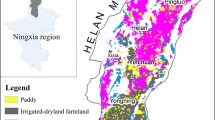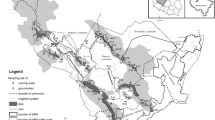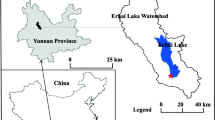Abstract
To reduce the harmful effects of irrigated agriculture on the environment, the evaluation of alternative irrigation water management practices is essential. The contents of total-phosphorus, nitrate nitrogen, and ammonium nitrogen in rural aquatic bodies typical of the Taihu Lake region (Yixing, Wangzhuang, and Xinzhuang) were determined during 2 years. The results showed that the concentrations of nitrogen and phosphorus during the rainy season were higher than in other months. The concentration of ammonium nitrogen in farmland drainage was higher than that of nitrate nitrogen. Ammonium nitrogen and nitrate nitrogen were the main pollution sources in rural groundwater. However, the pollution by ammonium nitrogen was worse than nitrate nitrogen. The annual average values of ammonium nitrogen in Yixing and Wangzhuang were 1.596 and 2.103 mg L − 1; with maximum values of 5.782 and 5.441 mg L − 1, respectively, exceeding the lower limit for type V water quality by a factor of 10. Concentrations of nitrate nitrogen in groundwater in Xinzhuang from May to September exceeded the limit value (10 mg L − 1) for drinking water prescribed by the World Health Organization. Therefore, this groundwater was not suitable to drink. In Taihu Lake, the average concentration of phosphorus over 2 years was 0.492 mg L − 1 and pollution by phosphorus in Taihu Lake was worse than other farmland drainage because of the trend of total-phosphorus accumulation. In addition, the average concentrations of nitrate nitrogen and ammonium nitrogen in Taihu Lake were 2.152 and 2.885 mg L − 1, respectively over 2 years, indicating that the water in the Taihu Lake is constantly in danger of eutrophication. Because of the transformation of ammonium nitrogen to nitrate nitrogen, there was a connection between the concentrations of ammonium nitrogen in farmland drainage and nitrate nitrogen in groundwater. There was also a significant positive linear correlation between the concentrations of ammonium nitrogen in farmland drainage and in shallow groundwater.
Similar content being viewed by others
Explore related subjects
Discover the latest articles and news from researchers in related subjects, suggested using machine learning.References
Boers, P. C. M. (1996). Nutrient emissions from agriculture in the Netherlands: Causes and remedies. Water Science & Technology, 33(4–5), 183–189.
Bouman, B. A. M., Castaneda, A. R., & Bhuiyan, S. I. (2002). Nitrate and pesticide contamination of groundwater under rice-based cropping systems: Past and current evidence from the Philippines. Agriculture, Ecosystems & Environment, 92(2–3), 185–199.
Bowden, W. B., Mcdowell, W. H., Asbury, C. E., & Finley, A. M. (1992). Riparian nitrogen dynamics in 2-geomorphologically distinct tropical rain-forest watersheds—Nitrous-oxide fluxes. Biogeochemistry, 18(2), 77–99.
Chen, H. S. (2001a). Restoration project of the ecosystem in Taihu Lake. Resources & Environment in the Yangtze Basin, 10(2), 173–178 (in Chinese).
Chen, Q. (2001b). Self organization feature maps for analysis of aquatic data—A case study of eutrophication analysis in Taihu Lake. Journal of Hydraulics Engineering, 6(1), 94–99 (in Chinese).
Chen, W. X. (1990). Agriculture environmental protection, (pp. 93–98). Beijing: China Agriculture Press (in Chinese).
Chen, X. M., Shen, Q. R., & Pan, G. X. (2003). Characteristics of nitrate horizontal transport in a paddy field of Taihu Lake region, China. Chemosphere, 50, 703–706.
Corwin, D. L., & Wagenet, R. J. (1996). Application of GIS to the modeling of nonpoint source pollutions in the vadose zone: A conference overview. Journal of Environmental Quality, 25(3), 403–411.
Gao, C., & Zhang, T. L. (1999). Environmental management options practiced in Europe to mitigate agricultural nutrient pollution of ground and farmland drainage. Rural Eco-environment, 15(2), 50–53 (in Chinese).
Gao, C., Zhu, J. G., & Dou, Y. J. (2005). Contribution of agricultural non-point source pollution to water quality deterioration in Taihu Lake watershed: Recent trends and research priorities. Resources & Environment in the Yangtze Basi, 11(3), 260–263 (in Chinese).
Hasegawa, K., Hanaki, K., Matsuo, T., & Hidaka, S. (2000). Nitrous oxide from the agricultural water system contaminated with high nitrogen. Chemosphere-Global Change Science, 2(3–4), 335–345.
Hu, B. B. (2003). Analysis on effect of water pollution in Taihu Lake basin on water quality of Tai Lake. Shanghai Environmental Sciences, 22(12), 1017–1021 (in Chinese).
Hu, X. F., Xu, S. Y., & Chen, Z. L. (2002). Status quo and strategies of pollution on middle and small creeks in suburb of Shanghai. Agro-environmental Protection, 21(3), 204–207 (in Chinese).
Li, L. F., Li, Y. H., Dilip, K. B., Nian, Y. G., & Jiang, G. M. (2008). Potential of constructed wetlands in treating the eutrophic water: Evidence from Taihu Lake of China. Bioresource Technology, 99(6), 1656–1663.
Li, J., Yang, X. S., & Peng, Y. Z. (2002). Microbe and water treating engineering [M] (pp. 343–345). Beijing: Chemic industry (in Chinese).
Liu, Z. D., Yu, X. G., & Wang, Z. X. (2003). The current water pollution of Taihu Lake drainage basin and the new management proposals. Journal of Natural Resources, 18(4), 470–474 (in Chinese).
Lu, Y., Gong, Z. T., & Zhang, G. L. (2003). Phosphorus forms and adsorption-adsorption characteristics of urban soils in Nanjin. Chinese Journal of Soil Science, 34(1), 40–43 (in Chinese).
Lu, M., Xu, B., & Yang, X.-A. (2008). Evaluation method for water quality of Taihu Lake and its variation in recent years. Water Resources Protection, 24(5), 30–33 (in Chinese).
Mao, Z. P., Shan, B. Q., & Yin, C. Q. (2003). Spatial phosphorus retention in an agricultural headwater stream. Environmental Science, 24(6), 1–8 (in Chinese).
Minami, K., & Fukushi, S. (1984). Methods for measuring N2O flux from water surface and N2O dissolved in water from agricultural land. Soil Science & Plant Nutrition, 30, 495–502.
Minami, K., & Ohsawa, A. (1990). Emission of nitrous oxide dissolved in drainage water from agricultural land. In A. F. Bouwman (Ed.), Soils and the greenhouse effect, (pp. 503–507). Chichester: Wiley.
Pan, G., Wu, L., Li, L., Zhang, X., Gong, W., & Wood, Y. (2008). Organic carbon stratification and size distribution of three typical paddy soils from Taihu Lake region, China. Journal of Environmental Sciences, 20, 456–463.
Pu, P. M., Hu, W. P., Yan, J. S., Wang, G. X., & Hu, C. G. (1998). A physicoecological engineering experiment for water treatment in a hypertrophic lake in China. Ecological Engineering, 10, 79–90.
Qin, B. Q., Wu, Q. N., & Gao, J. F. (2002). Water environmental issues in Taihu Lake of China: Problems, causes and management. Journal of Natural Resources, 17(2), 221–228 (in Chinese).
Quan, W. M., & Yan, L. J. (2002). Effects of agricultural non-point source pollution on eutrophication of water body and its control measure. Acta Ecologica Sinica, 22(3), 291–299 (in Chinese).
Sims, J. T., Simard, R. R., & Joern, B. C. (1998). Phosphorus loss in agricultural drainage: Historical perspective and current research. Journal of Environmental Quality, 27, 277–293.
SPSS (2003). Analytical Software. SPSS Inc. Headquarters, 233 S. Wacker Drive, Chicago, IL 60606.
State Environmental Protection Administration of China (1994). Chinese groundwater quality criteria of classification, (GB/T14848-93), (pp. 23–32). Beijing: China Environmental Science Press (in Chinese).
State Environmental Protection Administration of China (2002). Environmental quality standard for irrigation water, China (GB3838-2002), (pp. 12–30). Beijing: China Environmental Science Press (in Chinese).
Ueda, S., Ogura, N., & Yoshinari, T. (1993). Accumulation of nitrous oxide in aerobic groundwaters. Water Research, 27(12), 1787–1792.
Vighi, M., & Chiaudani, G. (1987). Eutrophication in Europe: The role of agricultural activities. In E. Hodgson (Ed.), Reviews in Environmental Toxicology #3. Amsterdam: Elsevier.
Wang, D. H., & Liang, C. H. (2002). Transportation of agriculture phosphorus and control to reduce the phosphorus loss to water: A review. Soil & Environmental Sciences, 11, 183–188.
Xiong, Z. (2002). Non-point source nitrate pollution of lakes, rivers and wells in the Taihu Lake region. Rural Eco-Environment, 18(2), 29–33 (in Chinese).
Xu, L. G., & Zhang, Q. (2006). Status and prospect of models for non-point source pollution. Journal of Agro-Environment Sciences, 25, 316–322 (in Chinese).
Yu, X. X., Yang, G. S.,& Ou, W. X. (2003). Impacts of non-point source pollution on the water environment of Xitiaoxi watershed, upper Taihu Lake Basin. Journal of Lake Science, 15(1), 49–55 (in Chinese).
Yuan, S. F., Lu, J., & Yu, J. Y. (2004). Methods of prevention and cure to ANPSP caused by nitrogen and phosphorous. Journal of Soil & Water Conservation, 18(1), 122–125 (in Chinese).
Author information
Authors and Affiliations
Corresponding author
Additional information
Project supported by the National Natural Science Foundation of China (No. 40371055).
Rights and permissions
About this article
Cite this article
Chen, X., Wo, F., Chen, C. et al. Seasonal changes in the concentrations of nitrogen and phosphorus in farmland drainage and groundwater of the Taihu Lake region of China. Environ Monit Assess 169, 159–168 (2010). https://doi.org/10.1007/s10661-009-1159-3
Received:
Accepted:
Published:
Issue Date:
DOI: https://doi.org/10.1007/s10661-009-1159-3




